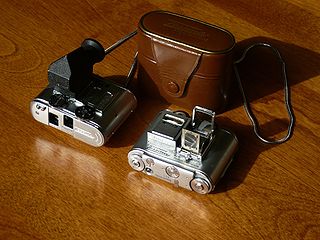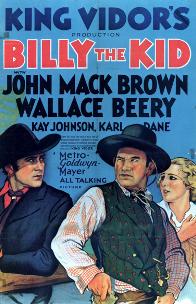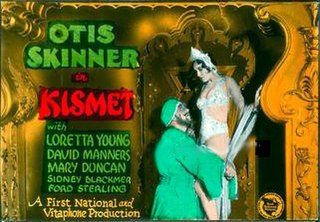
Widescreen images are displayed within a set of aspect ratios used in film, television and computer screens. In film, a widescreen film is any film image with a width-to-height aspect ratio greater than 4:3 (12:9).

35 mm film is a film gauge used in filmmaking, and the film standard. In motion pictures that record on film, 35 mm is the most commonly used gauge. The name of the gauge is not a direct measurement, and refers to the nominal width of the 35 mm format photographic film, which consists of strips 1.377 ± 0.001 inches (34.976 ± 0.025 mm) wide. The standard image exposure length on 35 mm for movies is four perforations per frame along both edges, which results in 16 frames per foot of film.

VistaVision is a higher resolution, widescreen variant of the 35 mm motion picture film format which was created by engineers at Paramount Pictures in 1954.

70 mm film is a wide high-resolution film gauge for motion picture photography, with a negative area nearly 3.5 times as large as the standard 35 mm motion picture film format. As used in cameras, the film is 65 mm (2.6 in) wide. For projection, the original 65 mm film is printed on 70 mm (2.8 in) film. The additional 5 mm contains the four magnetic stripes, holding six tracks of stereophonic sound. Although later 70 mm prints use digital sound encoding, the vast majority of existing and surviving 70 mm prints pre-date this technology.

Cinematography is the art of motion picture photography.

CinemaScope is an anamorphic lens series used, from 1953 to 1967, and less often later, for shooting widescreen films that, crucially, could be screened in theatres using existing equipment, albeit with a lens adapter.
A roadshow theatrical release or reserved seat engagement is the practice of opening a film in a limited number of theaters in major cities for a specific period of time before the wide release of the film. Roadshows would generally mimic a live theatre production, with an upscale atmosphere as well as somewhat higher prices than during a wide release. They were commonly used to promote major films from the 1920s–60s and build excitement.
Cinema Products Corporation was an American manufacturer of motion picture camera equipment.

Panavision is an American motion picture equipment company founded in 1954 specializing in cameras and lenses, based in Woodland Hills, California. Formed by Robert Gottschalk as a small partnership to create anamorphic projection lenses during the widescreen boom in the 1950s, Panavision expanded its product lines to meet the demands of modern filmmakers. The company introduced its first products in 1954. Originally a provider of CinemaScope accessories, the company's line of anamorphic widescreen lenses soon became the industry leader. In 1972, Panavision helped revolutionize filmmaking with the lightweight Panaflex 35 mm movie camera. The company has introduced other cameras such as the Millennium XL (1999) and the digital video Genesis (2004).

The Big Trail is a 1930 American pre-Code Western early widescreen film shot on location across the American West starring 23-year-old John Wayne in his first leading role and directed by Raoul Walsh. It is the final completed film to feature Tyrone Power Sr. before his death in 1931, as well as his only sound role.

The Movietone sound system is an optical sound-on-film method of recording sound for motion pictures that guarantees synchronization between sound and picture. It achieves this by recording the sound as a variable-density optical track on the same strip of film that records the pictures. The initial version was capable of a frequency response of 8500 Hz. Although modern sound films use variable-area tracks instead, modern motion picture theaters can play a Movietone film without modification to the projector. Movietone was one of four motion picture sound systems under development in the U.S. during the 1920s, the others being DeForest Phonofilm, Warner Brothers' Vitaphone, and RCA Photophone, though Phonofilm was principally an early version of Movietone.
70 mm Grandeur film, also called Fox Grandeur or Grandeur 70, is a 70 mm widescreen film format developed by William Fox through his Fox Film and Fox-Case corporations and used commercially on a small but successful scale in 1929–30.

Technirama is a screen process that has been used by some film production houses as an alternative to CinemaScope. It was first used in 1957 but fell into disuse in the mid-1960s. The process was invented by Technicolor and is an anamorphic process with a screen ratio the same as revised CinemaScope (2.35:1), but it is actually 2.25:1 on the negative.

The Tessina is a high-quality 35mm camera patented by Austrian chemical engineer Dr. Rudolph Steineck in Lugano Switzerland, manufactured by Siegrist in Grenchen Switzerland. It was introduced in 1957 and distributed by Steineck's company Concava S.A and remained in production up to 1996. The Tessina takes 14x21 mm pictures on standard 35 mm film, making it one of the few subminiature cameras to use the format. It is a very small (2.5x2x1 inch) twin lens reflex, with two 25 mm f/2.8 Tessinon lenses, one for taking the picture, the other for viewing on a tiny ground-glass focusing screen on top of the camera. A 45° mirror is employed to bend incoming light onto the film, which lies along the bottom of the camera rather than the back to save space. Apertures are continuously variable down to f/22, and shutter speeds range from 1/2 to 1/500, and B. The Tessina 35, Tessina L can focus down to 9 inches, Tessina Automatic 35mm to 12 inches. The film is advanced via a clockwork master spring built into the takeup spool, with a pullout winder like the crown on a wristwatch. Each winding can last up to 8 exposures.

Film perforations, also known as perfs and sprocket holes, are the holes placed in the film stock during manufacturing and used for transporting and steadying the film. Films may have different types of perforations depending on film gauge, film format, and intended usage. Perforations are also used as a standard measuring reference within certain camera systems to refer to the size of the frame.
Super Panavision 70 is the marketing brand name used to identify movies photographed with Panavision 70 mm spherical optics between 1959 and 1983.
BNCR is a lens mount developed by Mitchell for use with its reflex 35 mm movie cameras. It was an update of the BNC mount done to accommodate the reflex viewer in the later cameras. BNC mount lenses cannot be used in reflex Mitchell cameras as their shorter back-focus will hit and damage the reflex viewer, which, in various versions, was a pellicle mirror or a rotating mirror. The initials stand for Blimped Newsreel Camera Reflex, which meant that it is a 35 mm camera originally intended for news reporting but included a blimp housing for sound stage shooting plus a reflex viewer to allow the camera operator to view the action through the lens while filming. The reflex option was only added in 1967, while the blimp option - thereby converting an NC into a BNC, - was available at the camera's introduction in 1934, but only a few BNC examples were made before the onset of WW-II, during which manufacture of "production" cameras was suspended.

Billy the Kid is a 1930 American pre-Code Western film directed in widescreen by King Vidor about the relationship between frontier outlaw Billy the Kid and lawman Pat Garrett. In February 2020, the film was shown at the 70th Berlin International Film Festival, as part of a retrospective dedicated to King Vidor's career.

Kismet is a 1930 American pre-Code costume drama film photographed entirely in an early widescreen process using 65mm film that Warner Bros. called Vitascope. The film, now considered lost, was based on Edward Knoblock's play Kismet, and was previously filmed as a silent film in 1920 which also starred Otis Skinner.

South Pacific is a 1958 American romantic musical film based on the 1949 Rodgers and Hammerstein musical South Pacific, which in turn is loosely based on James A. Michener's 1947 short-story collection Tales of the South Pacific. The film, directed by Joshua Logan, stars Rossano Brazzi, Mitzi Gaynor, John Kerr and Ray Walston in the leading roles with Juanita Hall as Bloody Mary, the part that she had played in the original stage production. The film was nominated for three Academy Awards, winning the Academy Award for Best Sound for Fred Hynes. It is set in 1943, during World War II, on an island in the South Pacific.

















